The Sweat Bee, Yellow Jacket and Hoverfly Debacle
Man o’ man, I’ve seen some heated discussions about the whole sweat bee controversy lately on some homesteading sites. Folks gettin’ themselves all worked up.
Part of the problem as I see it, stems from the fact that different regions of the U.S. call things by differing names. It doesn’t help matters any, that there is a western and eastern version of sweat bee that look nothing alike. I believe here in lies much of the confusion.
I grew up in Kentucky and a sweat bee to my Grandpa was actually a yellow jacket, and what he called a yellow jacket was actually a hoverfly. It’s all a big ole ball of he said, she said that can be easily remedied, once you know what you’re lookin’ at.
What is a sweat bee? You can ask three different people and probably get three different answers. Luckily, I think I can shed some light on this confusion.
Lets begin with actual sweat bees, then we’ll move on to the “imposters”.
Eastern sweat bees (scientific name – Dialictus zephrum) are black and tiny.
 *
*
They can also look metallic in appearance with hues of greens, blues or gold. The females are the only one that sting and usually only when squashed or in attempts to brush them away. They continue to pump venom into you until you remove the stinger. For such a tiny creature, they sure pack a wallop.
The Western sweat bee (Nomia melanderi) is slightly smaller than a honey bee and has thin, yellow or green iridescent bands on its abdomen.
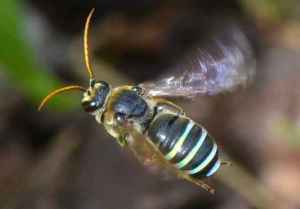 *
*
They are often times referred to as “alkani bees” and get that name because they nest in the alkaline soil of the desert regions. As with the Eastern variety, they only sting when swatted or startled. This particular bee is vital for the pollination of alfalfa fields.
Both are ascribed the moniker of “sweat bees” because they are attracted to the salts in perspiration.
[Factoid] Because the eastern bees are so small, I have heard them referred to as, baby bees. There is no such thing as babies or juveniles when it comes to bees, wasps or flies. They all go through a four stage growth process: egg, larva, pupa, and then adult. They present with wings in this adult stage. At this point, they are about as big as they are gonna get.
Now to move on to the posers and wanna bee’s.
Yellow Jackets (Vespula maculifrons) are actually wasps, not bees.
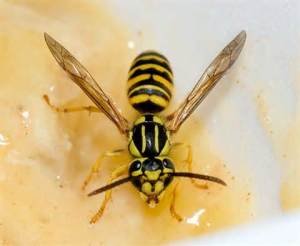 *
*
They are bold and aggressive and are attracted to sweets and meat, having put the kibosh on many a picnic outing. You often times see them hanging around open trash cans. Their bodies are about ½” long, give or take and are smaller and more narrow than a honey bee.
Unlike bees, yellow jackets do not leave stingers embedded in humans when they sting. The sting of a yellow jacket is very painful, they are equipped with lance like smooth stingers, and are capable of stinging repeatedly. If agitated, it marks aggressors with its built in alarm system of pheromones, which alerts and sets off an attack by guard wasps close by that will pursue and sting you.
Last but not least is the Hoverfly (Syrphidae), often times called a “flower fly”.
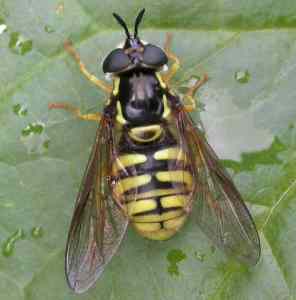 *
*
They get their name because you can see them hovering, much like a hummingbird as they drink nectar from field flowers. They are very beneficial, as their larvae eat pest aphids on plants and crops and they are wonderful pollinators that can not sting.
On first glance it resembles the yellow jacket, and it relies on this extraordinarily effective defense system of mimicry.
Here are a couple comparison charts for your inspection.
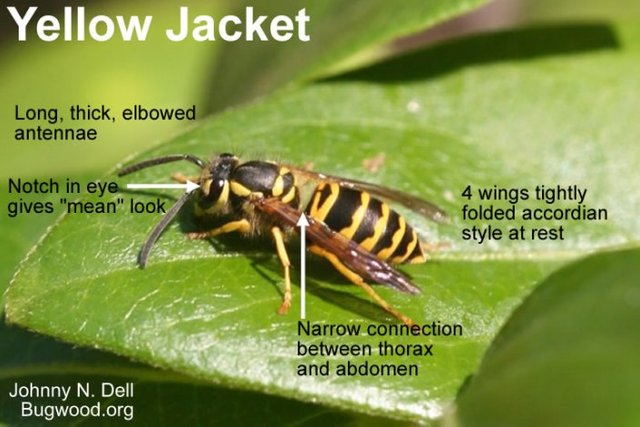 *
*
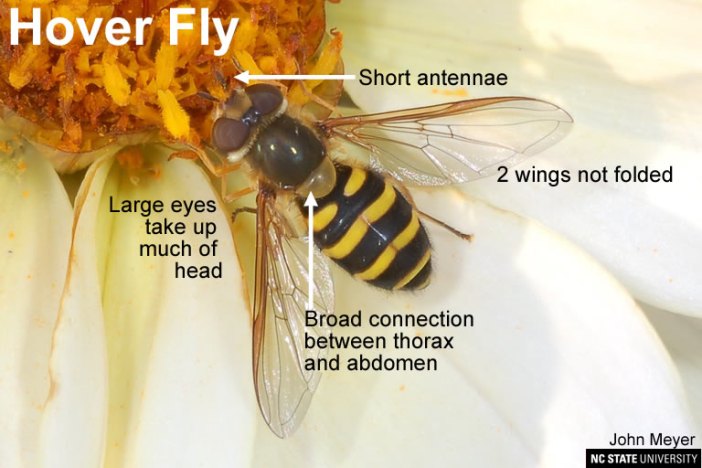 *
*
When trying to differentiate between a yellow jacket and a hoverfly, the first thing to be noticed are its wings. Flies only have two wings and they stay open, whereas bees and wasps have four tightly folded wings at rest. Another way you can tell the difference, bees do not have those huge fly eyes, and boom there you go.
This wouldn’t be a homesteading page if I didn’t at least provide a remedy or two. Here are some home concoctions that actually work on insect stings.
I remember an old neighbor down the road making a paste of baking soda and water. He put a glob of it on a band aid and sent me home after I was stung helping him move a small wood pile.
As an adult I have made a poultice or paste by chewing a leaf of plantain (a common weed for a lot of us) and holding it on the sting. The relief effects are almost instant. This is my go to treatment in all but the winter months.
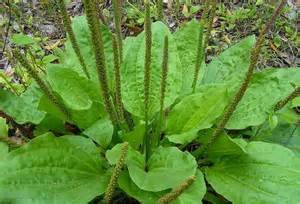 *
*
Note the larger the leaf, the more bitter it will taste, so pick young tender ones if possible.
My Granny was born in Germany, in 1889. She was a tough old Frau and died when I was nine, but I remember her slicing an onion and placing the wet side on stings.
Well, I hope this helped to clear up some confusion and define the differences between all these insects. Plus add a few new tricks in your bag of home remedies. Till next time.
Onward in Strength,
Mary Lotus
*(All photos found on Google images)
This was interesting information about what might be a bee in the garden. Here in California I've seen the Alkali (We call them sand bees), of course honey-bees, big furry bumble bees, yellow-jacket wasps (evil little f#@!rs), and brown gall-wasps (lots of oak here). Not sure I've seen the flies that look like bees though.
I am continually amazed by the number of pollinators that I have in my fields and gardens. I have seen so many that I have yet to identify. It's hard, they're fast little suckers.
I've never been to California, but I'd love to visit. So much to see and experience there.
There is, I've been trying to bring little snippets of it through my eyes to people through use of the #hiddenplaces tag ... I encourage others to do the same with your neighborhoods!
#hiddenplaces, I'm gonna check that out.
Very informative and glad to know I had them right haha. Just found a nest of yellow jackets in my gutter today, so good timing as well. Thank you.
Yikes, those things are vicious, be careful.
Worst part..I plugged their hole and now they are in my sun room..argh. hoping they fly out with the door open..haha...or fly in, I know. So far mostly out.
Haha, those are the lessons we remember. I've done some doozies, down her eon the farm.
Great read thanks. I have been thinking carfeully about the kind of flowers I plant to attract these little polinators, with out them I dont get fruit or veg :) And what I can plant to replel the bad ones! I have been planting alot of Lavender as its quite drought tollerent, and once I planted nasturtiums .. now they grow like weeds year afer year lol. Thanks for sharing :)
I also plant for pollinators, they are so important. Yum, nasturtiums. I love eating them. I call them the pepper of the flower world.
Yellow Jackets are bad here. I have to always be on the lookout for their nests when moving so that I can tell my husband. He's allergic to bee stings.
Thank you for commenting on my post, I followed you. I homestead and do Permaculture to.
Plantain makes a fantastic spit poultice. I keep dried for the winter months.
Plantain is a wonder plant. I can't believe I killed it off for so many years. The same goes for mullein.
I wish I had taken my PermaCulture classes before I set up my gardens and orchards. I just took one from Oregon State University that focused on drought proofing your land. I sure would have arranged things differently. Hey, that sounds like a good blog post to write about, haha.
For those following along, I was introduced to MOOC's (Massive Open Online Courses) that are free and offered by many university's. They are online classes that you take. Usually, there are a few tests but nothing like turning in papers and is a pass/fail. You normally get a certificate or badge after passing. There is one for those looking to learn about entry level PermaCulture too.
I think it would be a wonderful post! I studied for years and also found a UNC course by Dr Will Hooker for free. I love mullein for lung health.
What a great post!! I've been wondering myself about the various species of bees and wasps. Do sweat bee provide a large role in pollination? I would assume since they are drawn to sweat that they wouldn't be very helpful, but everytime i go to kill on of those little buggers hanging out on my neck, I stop short and wonder if I should really be killing any kind of pollinator. So i blow them away for the next ten minutes. lol
As far as a "large role in pollination", I could not say, but now, I definitely want to find out, haha. I do know that every time I try to swipe them away I get stung. Every friggin' time. Heading off to research their role in pollination.
every time!!! lol it's interesting, i learned something from this post and was able to share it with a fellow mama whose son got a sting. So Thankyou very much for the free education!!!
You're more than welcome.
Congratulations @themerrylotus! You have completed some achievement on Steemit and have been rewarded with new badge(s) :
Click on any badge to view your own Board of Honor on SteemitBoard.
For more information about SteemitBoard, click here
If you no longer want to receive notifications, reply to this comment with the word
STOP